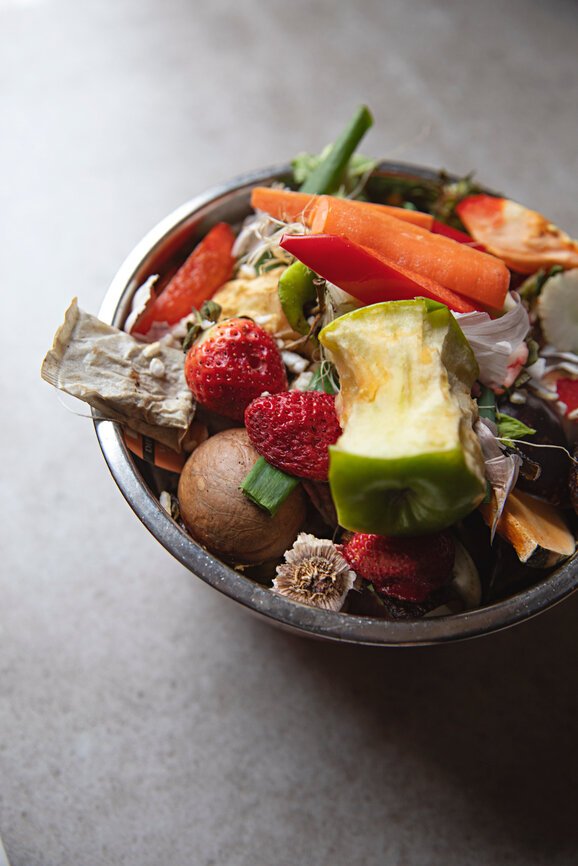
A Step-By-Step Guide To Composting, Wherever You Are
How To Compost At Home—Even If You Live In A Small Space
I’ve wanted to try composting for some time, but the concept has always intimidated me. Letting food decompose on your counter? Does it smell? How do you know if you’re doing it right? The task seemed complicated and a bit terrifying.
Then I watched this video with Lauren Singer, a zero-waste maven and the CEO and Founder of Package Free Shop. She made it seem easy, fashionable, and even fun. I decided it was time to put my fears aside and try it for myself.
I purchased this stylish compost bin from Helen Milan and, when it arrived, I immediately began tossing my food scraps into the container. Once it was full, my husband and I let it sit under our sink until we had time to take it to our local compost drop-off.
“Composting can help to impact the future health of our planet.”
But that’s when the smell started. We opened the bin, and under the top layer of our compost was what could only be described as a living science experiment. The fertilization process had started (a good sign!), but the stench was unbearable. I quickly Googled for a solution. Turns out, the smell is caused by composting incorrectly (oops).
Let’s just say I jumped into composting without fully educating myself about all the necessary steps first. While the process is easy, it does take a bit of learning—like with any new hobby or skill. The effort is especially worth it when composting can help to impact the future health of our planet.
Why Food Waste Matters
Why compost? Well, most of us toss organic matter into the garbage, right? (Think carrot skins, banana peels, or eggshells.) We often consider natural compounds to be helpful in breaking down waste by adding biodegradable matter to the process. Unfortunately, the opposite is true. For food to decompose properly, it needs oxygen.
“17 percent of the United State’s methane emissions come from landfills—and the number keeps growing.”
But landfills become tightly packed with our trash, forcing food to break down without oxygen. This generates a greenhouse gas (called anthropogenic methane), and it’s harmful to the environment because it rapidly warms the earth.
According to National Geographic, methane is “28 times more powerful than carbon dioxide at warming the Earth, on a 100-year timescale, and more than 80 times more powerful over 20 years.” It’s estimated that 17 percent of the United State’s methane emissions come from landfills—and the number keeps growing. Yikes.
Although this data makes me want to pack my bag and live off-grid, it feels empowering to know composting can make a difference. Mindful food waste disposal is possible, and I’ve discovered it can even be fun! By making the switch to composting, we can take the future of the planet into our own hands.
How To Start Composting
Composting is a method of food disposal where the organic matter gets the oxygen it needs to break down effectively. When exposed to the right amount of air and water, the result is a nutrient-dense fertilizer that can return to the earth.
While composting may seem daunting, and it can take time at first, it’s a fairly simple habit change that makes a big difference. Here are a few tips and tricks for getting started:
1. Evaluate Your Space & Needs
The compost system you choose depends on your space and the amount of time you have to keep your compost healthy. Once my husband and I have the basics down, we hope to move to a larger outdoor pile as an outdoor compost system which is excellent for soil and can help your garden grow.
For now, though, we use a small bin that doesn’t take up a lot of space. And it’s perfect for anyone living in urban settings. When done correctly, there’s no need to worry about smell or pests—just make sure to get a bin with an airtight lid. Here’s a list of some compost bins so you can find the right one for your home.
2. Use The Color-Coded Method To Start Your Pile
Start with “brown” material, such as twigs or dried leaves. If you don’t have access to nature, you can use paper, napkins, and dry coffee filters. When separating food and waste, remember the “color-coded formula.” A balanced compost is two to three parts “browns” (carbon-rich material) for every one-part “greens” (nitrogen-rich organic matter—e.g., veggie skins, fruits, coffee grounds, and even tea bags). After you build your brown layer, you can add greens (or wet food scraps). Alternate between green and brown layers as you fill the bin. As the contents decompose, it will become less full, and the alternating can continue.
“When the compost is too wet, it’s not able to break down and that’s when the dreaded smell and an unhealthy rot starts.”
Just remember, brown material is necessary. When I started my compost bin, we did not add any brown matter (big mistake). This dry material helps maintain healthy moisture levels inside the container. When the compost is too wet, it’s not able to break down and that’s when the dreaded smell and an unhealthy rot starts. Also, be mindful about greasy food—e.g., meat, bones, dairy, and anything covered in oil. These need to go in a regular waste bin.
Here’s a comprehensive list if you’re wondering about a specific food scrap.
3. Maintain Your Pile
The key to sustaining a compost pile or bin is to keep it healthy. Compost is a living, breathing thing and it needs love like anything else. Consider yours a part of the family! Tend to it often, give it nutrients, and a healthy environment so that it will prosper. Here are a few other key practices to remember:
Always mix any added material with the lower layers.
The contents should remain as wet as a wrung-out sponge.
Add dry material or water to maintain a healthy moisture level.
Mix or turn your compost at least once a week to help eliminate odor.
Freeze your compost when it’s full until it can be discarded appropriately.
4. Empty Your Compost
Now that you have a full bin, you need a place to put your compost! Thankfully, many cities offer compost drop-off points, or you may have a local garden accepting compost donations. Alternatively, you can use the compost in your yard or for your plants (or ask your neighbors if they need it!)
Use this list or this app to find a compost drop-off near you as an easy place to start. Where I live, we have a compost drop-off that’s then used towards our community garden. Some cost an annual fee, while other programs are free for the public.
5. Finally, Remember That It’s A Learning Process
No matter which method you choose or where you live, composting is an impactful, food-waste solution and an interactive hobby! The process may feel daunting at first, but once you see your food waste turn from trash into a healthy fertilizer, it all feels worth it.
“Once you see your food waste turn from trash into a healthy fertilizer, it all feels worth it.”
And if you need more tips and tricks, I recommend watching composting videos and following Instagram accounts for visual reference. These are especially helpful whenever I feel confused about separating green and brown matter. Also, this in-depth Composting 101 guide from the Natural Resources Defense Council is filled with a long list of tips, tricks, and compost systems to take your knowledge even further!
For those who’ve been composting for a long time, we’d love to hear what has worked or hasn’t in your composting journey. Share in the comments below!
RELATED READING
Courtney Jay is a writer at The Good Trade. She is also a yoga instructor, health enthusiast, and sustainable fashion advocate. She believes the most powerful way to nurture the planet is to nurture ourselves. You can find more of her writing and take one of her online yoga classes on her website Coincide.
